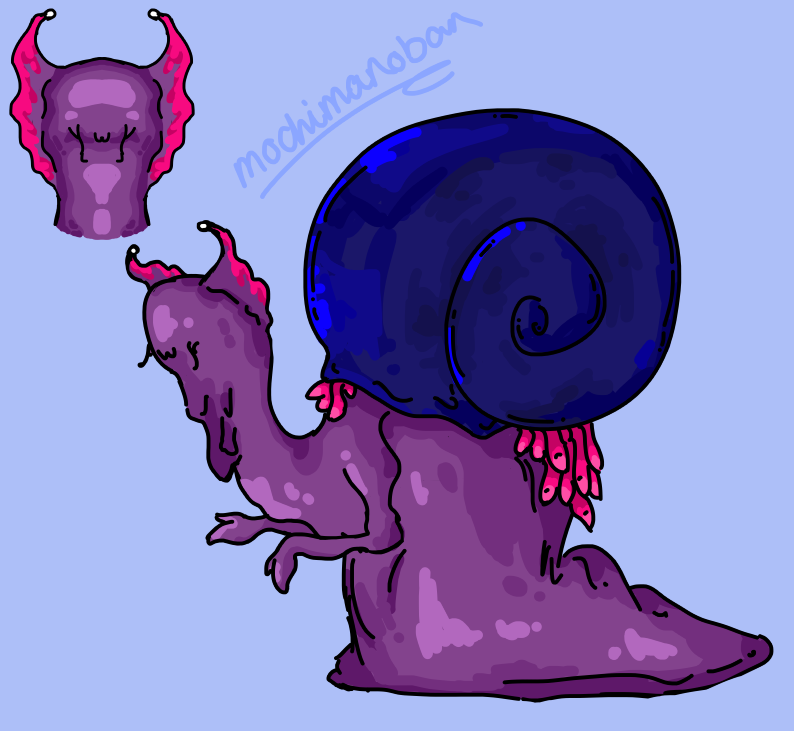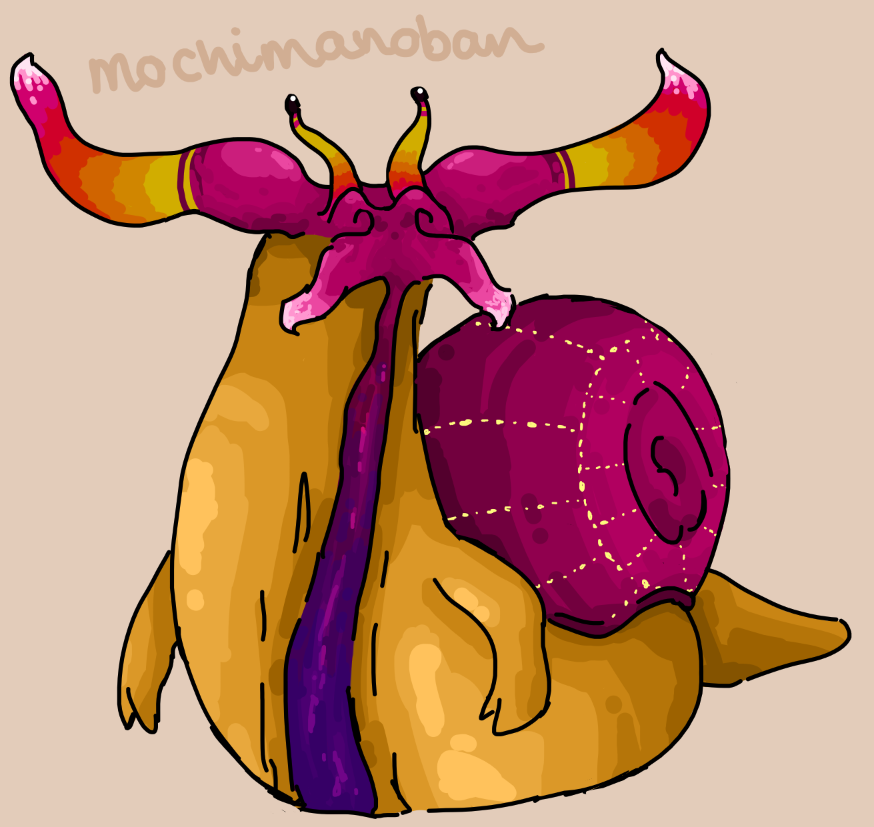Metraphite
Metraphites are the snail people of Ivucarro, a planet in the Kurhira System. These people are outgoing, gregarious, and exceptionally friendly. Metraphites are strong allies with slimes, their squishy planetary neighbours.
Metraphites are hyper-adaptive, meaning they can undergo a rapid form of adaptation to better suit their environment. These people exhibit non-progenic hyper-adaptivity, which allows them to adapt to their surroundings as many times as they like.
Taxonomy
These people place themselves within the order Stylommatophora, under the class Gastropoda. Stylommatophorans are land-breathing snails that lack an operculum, a calcified trapdoor that blocks outside stimuli from a retreated snail. Metraphites instead use secretions to seal their shell once retreated.
Anatomy
So... you're a slime? And you're a slime? What are you?A metraphite.Oh. Wait, what's the difference?I'm prettier.
Many believe metraphites have achieved their evolutionary peak, as they can adapt to pretty much any environment they face.
Cells grow and die at an incredibly fast rate, rapid mutations accounting for every single environmental change one comes up against. Large changes in their physical anatomy may only become apparent after a few months, but on a cellular level, these changes are ever-present.
There are around fifty unique ethnic groups native to Ivucarro, hundreds more on other planets. Their bodies mimic the environments they live in, using hyper-realistic camouflage. For example, the biconicas of the Byssal Forest region have a blue, purple, and pink colouration, identical to byssal slugtrees.
Reproduction & Growth
Metraphites reproduce asexually, producing both male and female gametes. With no need to diversify offspring thanks to their hyper-adaptive abilities, most parents raise children on their own. It is customary for a metraphite to have their first batch children, and have them grow to adulthood before finding a life partner.
A single person will lay anywhere from ten to thirty spherical eggs in a single bundle. Few survive the first week, only one or two children making it to adulthood in a single batch. Parental instincts don't kick in until a child reaches about two years of age, the beginning of the pubescent period.
Children typically live with the parent for about five years. In some cultures it is customary for children to live with the parent far into adulthood, often until the parent reaches elderly years and needs taking care of.
Diet
How many licks until you get to the centre of that polyp? I'm ten thousand licks in. It's been five days. Please help me.
Metraphites are strict herbivores, only able to consume soft plant matter. Primitive metraphites only fed on a small handful of plant species, but in modern times almost any plant is turned into a paste and consumed.
In order to get all of the nutrients required, many people will lick corals and mushrooms readily available in most regions on the planet. Most basic plant matter contains the majority of the necessary nutrients, but for the healthiest lifestyle, added nutrients from these other sources are needed.
Society & Culture
Many cultures across Ivucarro share similar beliefs surrounding family and friendships. It is customary for a person to have their first set of children before finding a partner. Once people find a partner, they will have more children and collectively share the responsibilities of both sets of offspring.
Most people will only have one partner for the duration of their life, as well. This is a practice that has left their home planet and is seen in metraphites across the Milky Way, even in regions where polyamory is extremely common. While metraphites outwardly show support towards polyamory, many find it obscure, unusual, and deviant.
History
Early metraphites and other ancestral species dominated Ivucarro around ten million years ago. Natural selection meant the end to every other species besides metraphites, who only grew more and more intelligent. While they first evolved around the Liadin Rainforest and remained there for around six million years, they soon began to expand their territories north and south, exploring further regions and even stepping foot into further continents.
Collect a Sticker!
A friendly metraphites invites you into his shop. He sells assorted knick knacks, bite-sized treats, and stickers. Better add one to Your Stickerbook! Click to collect sticker: IvucarroAround four million years ago their hyper-adaptive abilities awoke. People that left the Liadin Rainforest would return unrecognisable, the only thing of their former selves remaining were their memories. The original group of metraphites did not recognise the returning people as their own species, and began treating them essentially as aliens.
As people diverged, new groups manifested in just a few years. Around fifty different groups of people had split off from one another, all adapting to the unique environments, rendering them completely unrecognisable from one another. It was only until twenty thousand years ago did people realise they were all the exact same species.
The study of hyper-adaptivity only became a trend a thousand years ago, as technological advancements increased. The Space Age for metraphites began five hundred years ago, just two years after a Starsaught Enterprises ship from Osao landed on the planet, and the world grew a little bit larger for these slow-moving gastropods.


















Stunning art. You specified that It's customary for a metraphite to have their first set of children before finding a partner in both Society & Culture and Reproduction & Growth, maybe just say it in one? Also, do these people have an natural predators?
Glad you like the art! I plan on revisiting this article anyways, I'll revise those sentences then :D I don't imagine them to have natural predators!